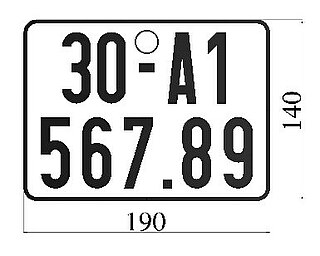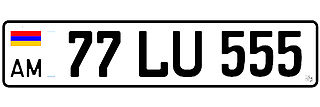
A vehicle registration plate, also known as a number plate or license plate, is a metal or plastic plate attached to a motor vehicle or trailer for official identification purposes. All countries require registration plates for road vehicles such as cars, trucks, and motorcycles. Whether they are required for other vehicles, such as bicycles, boats, or tractors, may vary by jurisdiction. The registration identifier is a numeric or alphanumeric ID that uniquely identifies the vehicle or vehicle owner within the issuing region's vehicle register. In some countries, the identifier is unique within the entire country, while in others it is unique within a state or province. Whether the identifier is associated with a vehicle or a person also varies by issuing agency. There are also electronic license plates.

Vehicles registered in Slovakia were generally assigned to one of the districts (okres) and from 1997 until 2022, the license plate coding generally consisted of seven characters and takes the form XX-NNNLL, where XX was a two letter code corresponding to the district, NNN was a three digit number and LL were two additional letters.
In New Zealand, vehicle registration plates contain up to six alphanumeric characters, depending on the type of vehicle and the date of registration. To be operated on any public road, most types of motor vehicles and trailers must be registered and display the corresponding registration plate(s). One plate must be affixed to the rear of the vehicle, and except in the case of a motorcycle, moped, tractor, or trailer, a second plate must be affixed to the front of the vehicle.
Argentine license plates are used to uniquely identify motor vehicles on the roads of Argentina. The current system employs three letters followed by three digits, issued consecutively, but the license plate system underwent significant changes before the use of this format.
Montenegrin car plates have black characters on a rectangular white background, with a blue strip on the left. Car, but not motorcycle, plates follow the 520 mm x 110 mm format. The old Yugoslav plate format was phased out from 6 June 2008 in favour of this format, which is on par with the common European Union format.
Standard Bulgarian vehicle registration plates display black glyphs on a white background, together with – on the left-hand side of the plate – a blue vertical "EU strip" showing the flag of Europe and, below it, the country code for Bulgaria: BG.
Vehicle registration plates of Serbia display black alphanumeric characters on a white background with blue field placed along the left side edge.

Brazilian vehicle registration plates are issued by the states. Each state has a Departamento de Trânsito (DETRAN) that is in charge of vehicle registration and car tax collection, but plates are standardized across the country and form a national vehicle registration database.
As of the year 2019 there are two different valid systems of vehicle registration plates in the Czech Republic.
Bosnia and Herzegovina vehicle registration plates have held their current form since 2 February 1998. Currently the Bosnia and Herzegovina (BiH) vehicle registration plate format consists of seven characters: five numbers and two letters arranged in the following order: X00-X-000. The plates are uniform across the country and do not denote the place where the vehicle is registered, as was the case prior to 1998. Likewise the plates do not contain any heraldic symbols. The plates use only letters which are represented equally in Latin and Cyrillic script.
In Albania, vehicle registration plates are issued by the General Directory of Road Transport Services.

License plates of Honduras are issued by the Honduran Secretaría de Obras Públicas, Transporte y Vivienda and identify motor vehicles in the country.

In Andorra, vehicle registration plates are composed of one letter and four digits, and have the coat of arms of Andorra and country code (AND) to the left of the serial and Principat d'Andorra in blue below the serial. The plates feature embossed black serials on a white background.

Current motor vehicle registrations in Chile are officially known as Placa Patente Única (PPU). This denomination was introduced when unifying the license plate registries at the national level, where each vehicle would carry a unique license plate in the country, in 1985.
Current motor vehicle registrations in Bolivia, commonly known as plate, are license plates with a unique combination of letters and numbers to individually identify each vehicle registered in the country.

Uruguay requires its residents to register their motor vehicles and display vehicle registration plates.

Vehicle registration plates of Vietnam generally take the form DDL-DDDDD for vehicles. Standard license plates have black characters on white background. Front plates measure 47 × 11 cm, rear ones are 27 × 20. In 2020 and 2021, both plates measure 6 x 12. The current scheme for civilian vehicles omits the letters I, J, O, Q and W, with the letter R reserved for trailers, and includes the Vietnamese D.

Vehicle registration plates of Armenia have black characters on a rectangular white background. They are composed of two or three numbers, two letters in the middle, and two other numbers. At the left side is located the international code "AM" with an oval car plaque and, sometimes, the national flag. Starting from 6 August 2014 a new design of license plates was implemented. The license plates have a national flag on the left side, a security hologram and a machinery readable Data Matrix Code.
Vehicle registration plates were used in the Soviet Union for registrations of automobiles, motorcycles, heavy machinery, special-use vehicles as well as construction equipment, military vehicles and trailers. Every vehicle registration plate contains a unique registration mark embossed on a metal plate or a plate made of other materials. All vehicles were required to display the plates on the front side and backside, with the exception of trailers and motorcycles, which were only required to display one on the backside.
The Australian state of New South Wales requires its residents to register their motor vehicles and display vehicle registration plates. Current regular issue plates are to the standard Australian dimensions of 372 mm (14.6 in) in length by 134 mm (5.3 in) in height, and use standard Australian serial dies.










